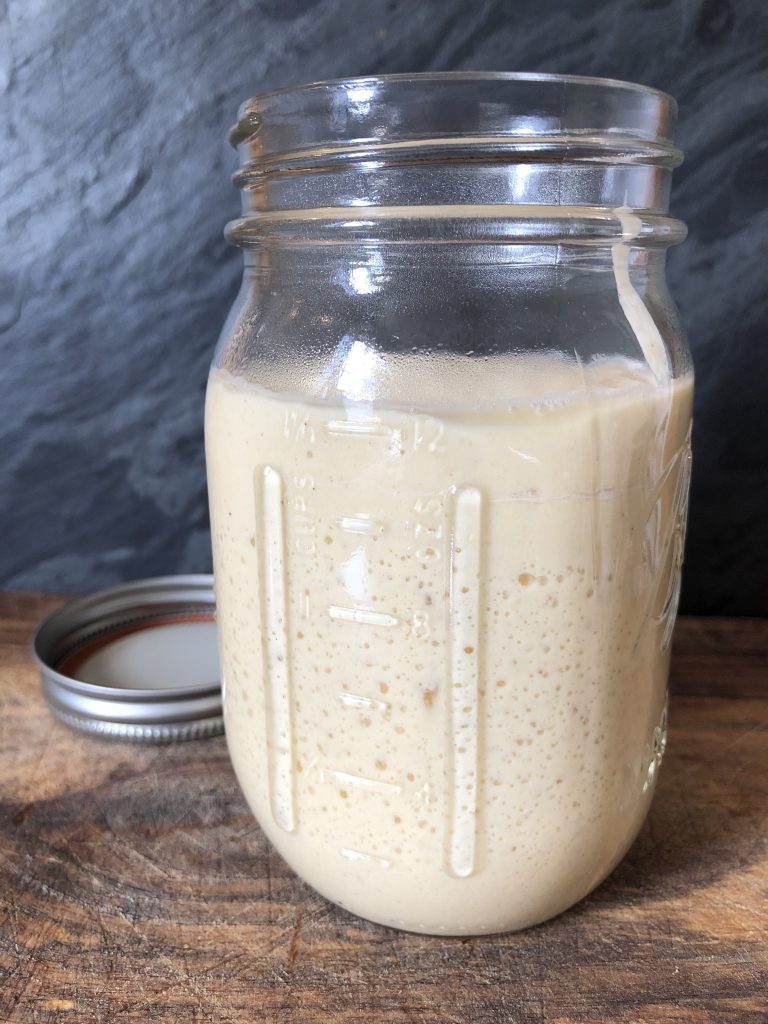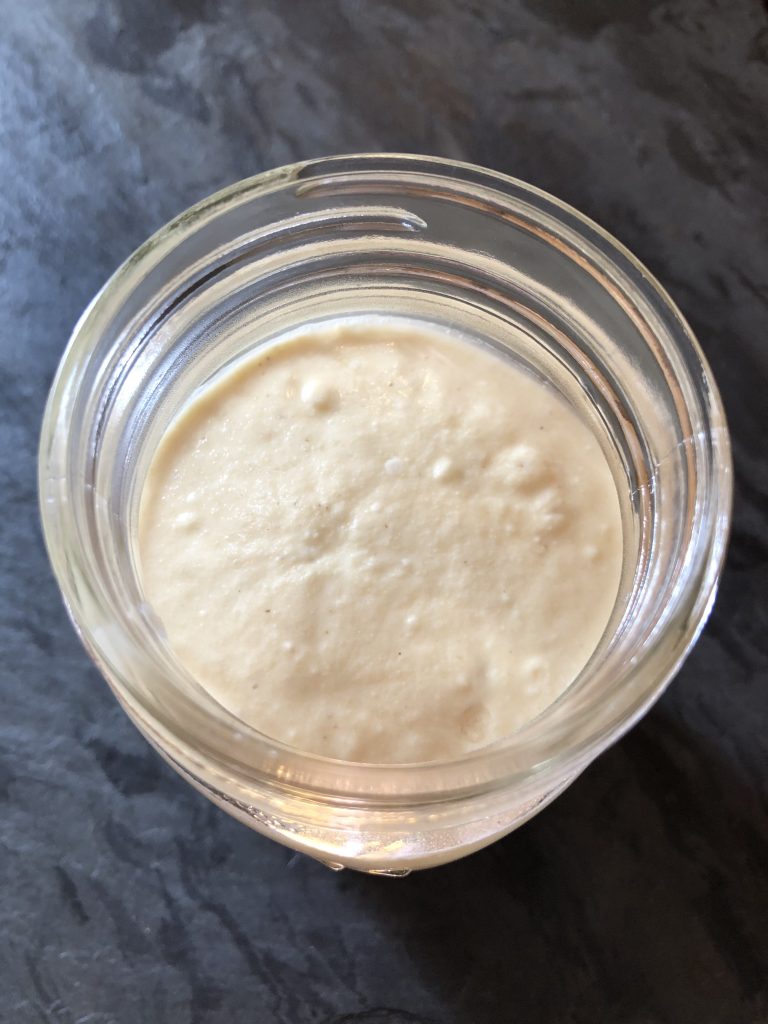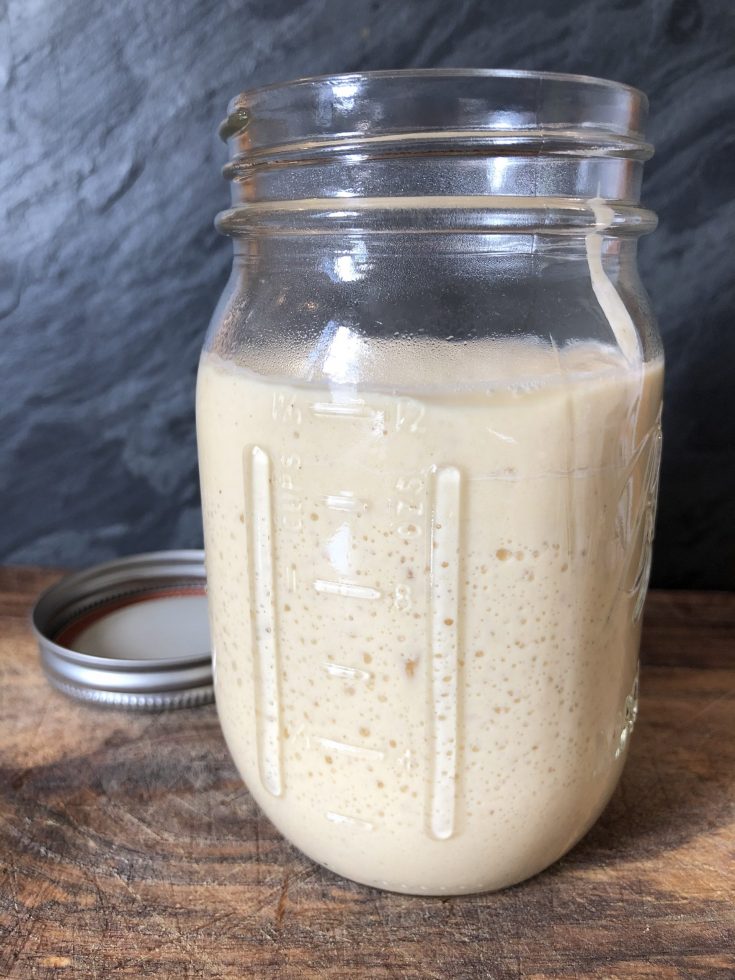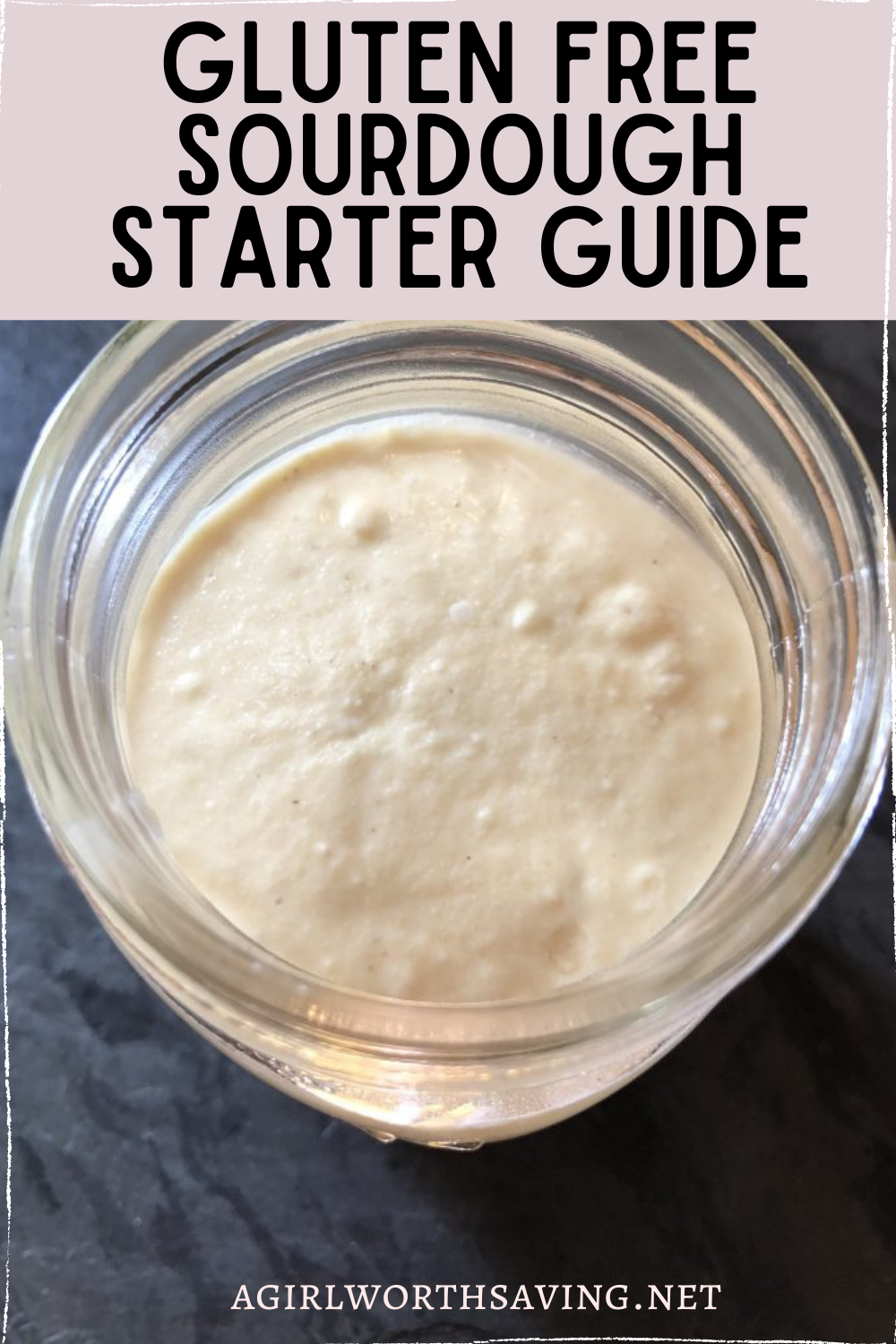This post contains affiliate links. Click here to read my affiliate policy.
Last Updated on December 8, 2023
Looking for the perfect gluten free sourdough starter recipe to enable you to make sourdough bread or baked goods? Take a look at our simple recipe!

Have you always wanted to make a gluten-free sourdough starter but don’t know where to start? Everyone around you seems to be doing it with different sourdough recipes, yet it feels like it’s very high maintenance because of all the steps you need to do as part of the process for a couple of days. And that’s often why you’re so discouraged from trying it on your own.
Today, I’ve brought you the easiest gluten-free sourdough starter recipe using wild yeast. Once you try it out, you’ll get addicted to making your sourdough breads and gluten-free baking in general!
Creating a sourdough starter is often compared to raising a pet. You have to feed and water it every day, ideally around the same time. You have to buy it food, watch it carefully for activity, and make arrangements for it when you go on vacation. With so much care involved, some people are deterred from ever trying to make one of their own. Let me put those concerns to rest with this simple method to bring a nice bubbly gluten-free sourdough starter to life.
The ingredients are simple, just gluten-free flour and water. You’ll need a clear, ideally glass container with either a lid or plastic wrap to loosely cover your starter. But most importantly, you’ll need patience. Sourdough is not a sprinting kind of baking, but a measured and even-paced journey.
The good news is that mixing and feeding the starter is super easy and fast. You just need to exercise some patience with your expectations of how quickly the starter will mature. Sometimes it bubbles to life in a handful of days, sometimes it takes several weeks. It’ll get there.

Ingredients
Don’t you love it when ingredients are kept to the minimum? Good news, that’s the case with this recipe. This is a two-ingredient and two-requirement sourdough starter gluten-free recipe where you’ll just need:
- Gluten-free flour
- Water
- Glass container with a lid
- Measuring cup
Yet, the essential ingredient to this gluten-free starter recipe is your patience. It takes a lot of time before your sourdough starter is ready to use. While the steps are super easy, you’ll need to be patient with the process of maturing the starter.
Recipe and Technique
Yield: About 1 cup of Sourdough Starter
Prep Time: 5 minutes a day
Total Time: 10 Days – 3 weeks
How to Make Gluten Free Sourdough Starter: The Recipe
Yield: Around 1 cup of sourdough starter
Prep Time: 5 minutes per day
Total Time: Between 10 days to 3 weeks
Let’s get into how to make a gluten-free sourdough starter from scratch!
Day 1:
On the first day, you’ll start by measuring one cup of gluten-free flour (approximately 164 grams) and stir it together with 3/4 of a cup and 2 tablespoons of cool filtered water (around 190 grams). Then, cover the cup with its lid or with a plastic wrap or rubber band and leave it at room temperature or in a slightly warmer than average temperature.
Day 2:
Visit your starter at the time you started creating it on day one. Since the changes might not be evident, smell your starter to recognize if there has been any progress. Make sure to look at it carefully and acquaint yourself with its smell to pinpoint its development and maturing.
Then, discard half of the starter and add 1/2 cup of fresh gluten-free flour (approximately 82 grams) and 1/4 cup + three tablespoons of spring water (around 95 grams). Stir the starter well and clean down the container’s sides. After that, cover it again, and ta-da, you’re done with your first feeding, which you’ll leave for 24 hours!
Tip: After you feed the starter for the first time, it’s normal to observe some bubbles or air pockets in your mix. In 5-6 days, your starter should rise with larger bubbles in the mixture. That’s precisely what the fermentation process is all about.
Day 3:
On day 3, repeat the feeding process, following the steps of day 2. Examine the sourdough starter, discard half of it, and add fresh gluten-free flour and water. You’ll repeat this feeding process daily until you’re ready to bake with your gluten-free sourdough starter.

After the first or second feeding, you may begin to see some tiny bubbles developing in your mix.
Day 5 or 6
You might begin to see your starter rising, with larger gas bubbles developing in the body of the mix and on the surface. Don’t be discouraged if it takes a little longer to see & smell changes. There are a lot of environmental factors at play here, but rest assured that wild yeast is everywhere. It’s only a matter of time before your starter begins to ferment.
What to Expect and Troubleshooting
Flour Blend Issues
When using wheat flour, it tends to rise and fall again as the sourdough starter matures and cycles after feeding. While that’s supposed to happen with a gluten-free sourdough starter too, it doesn’t completely fall again when the yeast has fully exhausted itself. This is because gluten-free flour absorbs water differently than traditional flour.
Just ensure that the sourdough starter develops enough yeast to produce gas and rises on a regular feeding cycle. It functions in this same manner to leaven your gluten-free sourdough bread.
I’m a fan of Bob’s Red Mill All-Purpose Baking Flour. It’s a garbanzo bean-based blend of all-purpose flour instead of other rice-based gluten-free flours, which provides a saturated texture, very similar to wheat-based starters. I don’t have anything against a brown rice flour blend either; it just has different requirements for the flour to water ratio.
Regardless of the flour blend you opt for; your target should be a tacky consistency when mixing flour and water, similar to pancake batter. While you’re stirring it, it’s normal to get some resistance, but after you leave it for some time, it should settle. That applies to every time you feed your sourdough starter!
Also, if you find the top of your sourdough starter to be thicker and dryer than the bottom, which is very wet, don’t panic! Just keep stirring it all before you discard half of the starter.
No Results?
If you don’t see any progress after approximately 10 days of feeding your sourdough starter, it probably needs a push with developing wild yeast. So, before you start mixing additional flour into the mix, toss the flour with unwashed grapes or berries (organic ones). Since they’re very high in sugar, they’re a natural attraction to wild yeasts.
Also, if you don’t have any, you could use a teaspoon of sugar. Just mix it directly with your sourdough starter to provide more food and energy for existing yeasts to join the mix.
Forgetting to Feed Your Sourdough Starter
It happens, and there’s a solution! When the greyish liquid starts forming on your sourdough starter, just pour it off. Alternatively, if there’s mold, scrape it off and move the rest of your sourdough starter to a clean mixing bowl, glass jar, or something similar. Then, feed it as you usually would, and it’ll balance itself out in a couple of days.
However, if you’ve “forgotten” about your sourdough starter for more than a week, I hate to say this, but it’s best to start over.
Vacation Plans
What if you suddenly have to leave your sourdough starter for 10 days? Is it just gone with the wind? Good news: no! Just feed it right before you travel and cover it tightly. Lastly, put the starter in the refrigerator on the coldest shelf.
By the time, the yeast will slow down its development until it stops, but when you’re back and start feeding it again at room temperature, it’ll restore itself.
Use this gluten free sourdough starter to make this delicious gluten-free sourdough bread or gluten free sourdough cinnamon rolls.

Gluten-free Sourdough Starter Guide
Make a gluten-free sourdough starter from scratch with this guide.
Ingredients
- 1 cup (164 grams) Gluten-free Flour
- ¾ cup + 2 Tablespoons (190 grams) cool water
Instructions
On the first day, you’re going to measure out a cup of gluten-free flour (164 grams) and stir it together with ¾ cup + 2 Tablespoons (190 grams) cool water. Cover with a lid or loosely with plastic, leave in a room-temperature or slightly warmer than average place, and make yourself a reminder to visit your starter at the same time again tomorrow.
On the second day, take a look at your starter and smell it. There probably won’t be any noticeable changes, but getting acquainted with your starter is key in recognizing when it’s developing, and eventually matures. The feeding process is a simple science, but using your senses to understand how your starter is progressing is the real art of sourdough.
After you’ve examined the starter, scoop out half of it, and discard it (or save it for another recipe.) Add ½ cup (82 grams) of fresh gluten-free flour and ¼ cup + 3 Tablespoons (95 grams) of water. Stir together, cleaning down the sides of the container, and cover. This is your first “feeding”. Leave it for 24 hours.
After the first or second feeding, you may begin to see some tiny bubbles developing in your mix. After about 5 or 6 days you might begin to see your starter rising, with larger gas bubbles developing in the body of the mix and on the surface. Don’t be discouraged if it takes a little longer to see & smell changes. There are a lot of environmental factors at play here, but rest assured that wild yeast is everywhere. It’s only a matter of time before your starter begins to ferment.
On the third day repeat the feeding process by first examining your starter, then discarding half of it and adding fresh flour and water. You’re going to repeat this feeding process every day until you’re ready to bake with it, and for as long as you want to keep it alive.



I’ve been searching for a gluten free sourdough instructions so this comes at perfect time! Thanks for such thorough instructions. Can’t wait to try this.
I tried a gf sourdough starter a few years ago. It was super finicky, so I gave up. I was using a rice-based flour, though, so I might try again with your tips. 🙂
Thank you for this easy to follow way to have my own sourdough starter! So glad that it’s gluten free!
I’ve been told by bakers that you can’t do a GF sourdough starter so thank you for this! I knew they had to be wrong. 😉
ooooh, I may have to give bread-baking a try with this!!
I’ve always wanted to try making this and had thought it would be super complicated. I had no idea that it only takes two ingredients. I’m excited to try this. Thanks for sharing this!